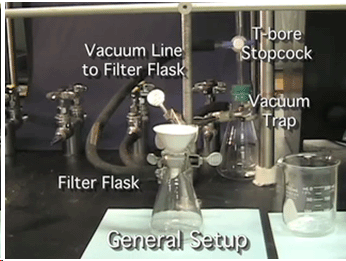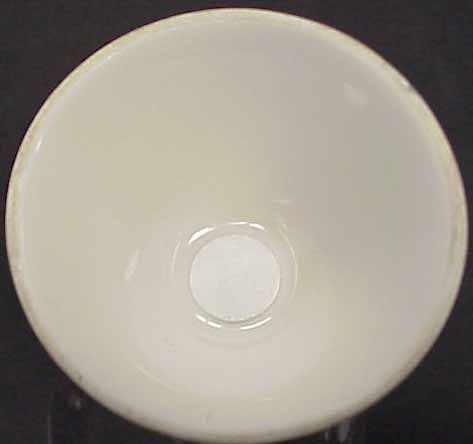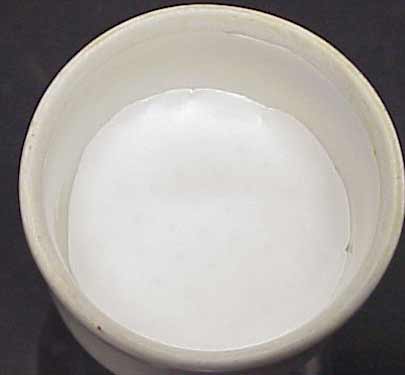
Vacuum filtration
Figure 1 shows a setup for a vacuum (or suction) filtration using a Hirsch funnel. A vacuum filtration is usually faster than a simple gravity filtration. However, there are several points that have to be considered.

front: filter flask with neoprene adapter (the black or grey rubbery thing in your drawer) and Hirsch funnel
back: vacuum trap with T-bore stopcock and thick-walled tubing
A vacuum filtration is usually faster than a simple gravity filtration using a simple conical funnel. However, there are several points that have to be considered when performing a vacuum filtration. Due to the fact that reduced pressure is used in this procedure, special attention has to be paid to the equipment used in this procedure. The glassware (i.e. filter flask) should not have any cracks on the sides or the bottom. It is also imperative that the filter flask and the vacuum trap are clamped securely, so that they do not move during the filtration. The thick-walled tubing tends to act like a whip sometimes, and slams the filter flask into the hotplate or other metal objects resulting in an implosion (or tips the flask over and the product is found afterwards on the bench or even worse on the dirty floor!).
The clean filter flask and the vacuum trap consist of heavy-walled glassware. Thick-walled tubing should be used as well. Normal tubings that are used as water hoses will collapse when a vacuum is applied!
Never perform a vacuum filtration without a vacuum trap. It is also a good idea to keep the trap clean, just in case something gets sucked in there. It is easier to recover it from a clean trap then from a dirty trap.
Vacuum filtrations can only be performed with funnels that have a flat surface e.g. Hirsch or Büchner funnel, which are both made from procelain! The filter paper has to cover all holes in the bottom of the funnel and does not extend up the sides. This means that the small pieces (~1.3 cm) of filter paper are used for the Hirsch funnel, and not a bigger circle hanging in the funnel. If the filter paper has the wrong size or not properly placed in the funnel, a significant part of the solid will "run through" the filter paper.
If the filter paper is too big for the Büchner funnel, it has to be cut to size with scissors. (From this point of view, it might be a good idea to generate a cardboard blank from an existing filter paper). The filter paper is moistened with the solvent that makes up the solution. This prevents the formation of multi-layer systems in the filter flask. It should adhere well to the bottom before the vacuum is applied. Then the solution is slowly poured slowly into the funnel.

Figure 2: Hirsch funnel with filter paper, all holes covered

Figure 3: Büchner funnel with filter paper extending up the side.
When a funnel is placed on top of the filter flask, a neoprene adapter (the black or gray "rubbery thing") or rubber stopper is used to ensure a good seal between the filter flask and the funnel.
When the filtration is finished, the tubing from the filter flask should be removed before the vacuum is turned off. This is less important when the house vacuum line is used like in the instruction lab, but it will be when an aspirator is used. The low pressure in the filter flask sucks the water back into the mother liquor, and if this is the part of interest, the experimenter is in big trouble.
Also, a vacuum filtration is not suitable for solvents with low boiling points e.g. diethyl ether, dichloromethane or other low boiling solvents. The solvent evaporates under the vacuum and the dissolved solids precipitate, clogging up the pores of the filter paper and get stuck on the insides of the funnel i.e. stem, etc. The same applies to hot solutions, since the solvent is close to its boiling point as well. In those cases, gravity filtration is used.
If a very fine precipitate has to be filtered, it is advisable to use some filter aid like diatomaceous earth or Celite. This will prevent that the holes of the filter paper will get clogged up too fast. This technique is obviously not very useful if the solid is the interesting part, because it will be very time consuming to separate the product from the filter aid.
Important Pointers:
1. Due to the fact that you are going to work with reduced pressure, special attention has to be paid to the equipment used. The glassware (e.g. filter flask) should not have any cracks. It is also imperative that the filter flask and the vacuum trap are clamped securely, so that they do not move anywhere. The thick-walled tubing tends to act like a whip sometimes, and slams the filter flask into the hotplate or other metal objects (which can cause an implosion), or just flips it over (and you product is on the bench or even worse on the dirty floor). You probably don't have any desire to collect your product from the floor, do you?
2. The filter flask and the vacuum trap consist of heavy-walled glassware. You should use thick-walled tubings as well. Normal tubing that you use as water hoses will collapse under vacuum. See link.
3. Never perform a vacuum filtration without a vacuum trap. It is also a good idea to keep the trap clean, just in case something gets sucked in there, it is easier to recover it from a clean trap then from a dirty trap.
4. Vacuum filtration is only suitable for funnels with a flat surface! The filter paper has to cover all holes in the bottom of the funnel (Hirsch or Büchner, both made from procelain) and does not extend up the sides. Otherwise a significant part of your solid will 'run through' the filter paper. Moisten the filter paper with the solvent that makes up the solution, and make sure that it adheres well to the bottom. Start up the vacuum and then slowly pour the solution into the funnel.
5. When you place a funnel on top of the filter flask, use a neoprene adapter (the black or gray 'rubbery thing') or rubber stopper to obtain a good seal.
6. When you done with the filtration, remove the tubing from the filter flask before you turn off the vacuum. It is less important when you use a house vac line like in the instruction lab, but it will when you use an aspirator (the thing using water). The low pressure in the filter flask sucks back the water into the mother liquor, and if this is the part that you are interested, you are back to square one.
7. A vacuum filtration is often not suitable for solvents with low boiling points i.e. diethyl ether, dichloromethane or boiling solvents. The solvent evaporates in the vacuum and dissolved solids precipitate, clogging up the pores of the filter paper.
8. If you have a very fine precipitate, it is advisable to use some filter aid like diatomaceous earth or Celite. This will prevent that the holes of the filter paper will get clogged up too fast. This technique is obviously not very useful if you are interested in the solid part, because it will be very time consuming to separate the the product from the filter aid.